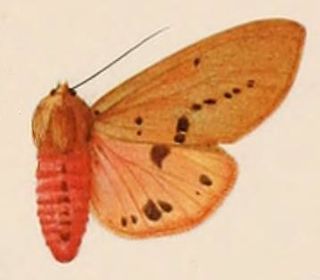Related Research Articles

Lophocampa affinis is a moth of the family Erebidae. It was described by Walter Rothschild in 1909. It is found in Mexico.

Spilosoma cajetani is a moth of the family Erebidae. It was described by Walter Rothschild in 1910. It is found on Seram Island.
Ambia melanalis is a moth in the family Crambidae. It was described by George Hampson in 1906. It is found in South Africa.
Pilocrocis pachyceralis is a moth in the family Crambidae. It was described by George Hampson in 1917. It is found in Papua New Guinea.
Samea choristalis is a moth in the family Crambidae. It was described by George Hampson in 1912. It is found in Trinidad.
Sinomphisa junctilinealis is a moth in the family Crambidae. It is found in Sierra Leone and Uganda.
Sufetula nigrescens is a moth in the family Crambidae. It was described by George Hampson in 1912. It is found in the Democratic Republic of the Congo, Ivory Coast, Madagascar, Nigeria and Sierra Leone.
Sufetula polystrialis is a moth in the family Crambidae. It was described by George Hampson in 1912. It is found on the Louisiade Islands.
Syllepte methyalinalis is a moth in the family Crambidae. It was described by George Hampson in 1912. It is found in Guyana.
Syllepte microdontalis is a moth in the family Crambidae. It was described by George Hampson in 1912. It is found in French Guiana.
Syllepte parvipuncta is a moth in the family Crambidae. It was described by George Hampson in 1912. It is found in Ghana and Sierra Leone.
Syllepte rogationis is a moth in the family Crambidae. It was described by George Hampson in 1918. It is found in Mozambique.
Syllepte orbiferalis is a moth in the family Crambidae. It was described by George Hampson in 1898. It is found on Réunion and in South Africa.
Syllepte melanopalis is a moth in the family Crambidae. It was described by George Hampson in 1908. It is endemic to Mayotte in the Indian Ocean off the coast of southeast Africa.
Syngamia albiceps is a moth in the family Crambidae. It was described by George Hampson in 1912. It is found in Singapore.
Udea ochropera is a moth in the family Crambidae. It was described by George Hampson in 1913. It is found in Colombia and Mexico.
Udeoides nigribasalis is a moth in the family Crambidae. It was described by George Hampson in 1913. It is found in Kenya.
Ulopeza denticulalis is a moth in the family Crambidae. It was described by George Hampson in 1912. It is found in South Africa.
Ulopeza junctilinealis is a moth in the family Crambidae. It was described by George Hampson in 1912. It is found in Indonesia (Bali).
Ulopeza sterictodes is a moth in the family Crambidae. It was described by George Hampson in 1912. It is found in Papua New Guinea.
References
- ↑ Nuss, M.; et al. (2003–2014). "GlobIZ search". Global Information System on Pyraloidea. Retrieved 2014-07-15.
- ↑ The Annals and Magazine of Natural History: Including Zoology, Botany, and Geology
| This Margaroniini-related article is a stub. You can help Wikipedia by expanding it. |